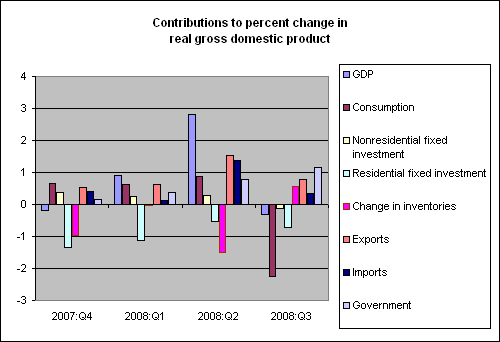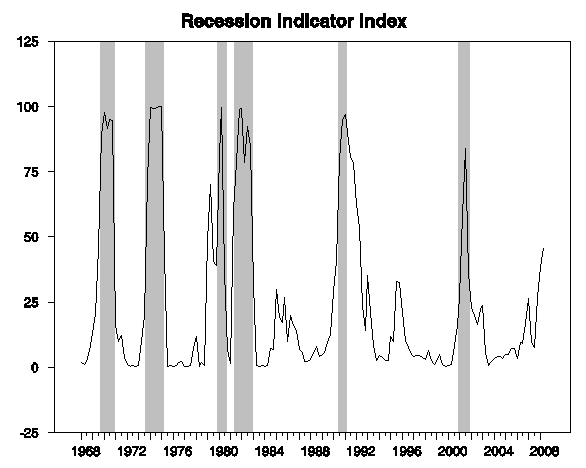The Bureau of Economic Analysis reported today that U.S. real GDP fell at a 0.3% annual rate in the third quarter of 2008. That’s the second quarter of negative real GDP growth out of the last four, and puts the cumulative annual growth since 2007:Q3 at an anemic 0.8%.

As expected, the most important factor was the 3.1% drop in real personal consumption expenditures during 2008:Q3. Given that consumption accounts for 70% of U.S. GDP, that by itself would have produced a -2.25% growth rate for real GDP if all the other components of GDP had held constant. Plumeting consumer confidence [1], [2], the end of mortgage equity withdrawal and a worsening employment situation were presumably responsible for the fall in consumption spending. Housing continued to be a drag on the economy– what else is new?– contributing -0.7% to the total GDP growth rate. Nonresidential fixed investment, which is key both for a cyclical recovery as well as longer run growth, fell slightly in the third quarter. Growth in exports and a fall in imports made a positive contribution, as did strong increases in government spending, which together kept the GDP total from being far more disappointing. But a weakening global economy and strained budgets for state governments make me doubt that we’ll see as strong numbers for exports and government spending in the fourth quarter.
The weak GDP report also led to a further increase in our recession indicator index, which now stands at 46.1% for 2008:Q2. This is an assessment based on a simple pattern-recognition algorithm of whether the GDP data available so far (through 2008:Q3) are more consistent with the statement that the economy in 2008:Q2 was in recession or expansion. The current value of 46.1% means you could easily call it either way, based on the conflicting evidence that the 2008:Q2 growth by itself looks reasonably healthy (+2.8%), but was preceded and followed by much weaker reports. As detailed in my paper written in 2005 with Marcelle Chauvet, we will declare that a recession has begun when the index moves above 67%. At that time we will use the full sample of data that is available at that time to assign a probable date to the beginning of the recession, based on the value of the revised full-sample index available at that time. My current expectation is that we’ll issue such a declaration when the 2008:Q4 GDP numbers are reported, and date the beginning of the recession as 2007:Q4.

|
Technorati Tags: GDP,
recession probability,
recession indicator index,
macroeconomics,
economics
I see that inventory accumulation added over half a point to GDP growth. My guess is that much of that was unintended inventory accumulation. And unintended inventory accumulation is hardly a positive sign.
Huge bump in defense spending.
But how likely are PCEs to fall by 3% again? It would seem not that likely given that this was the largest fall since 1980 and commodity prices have collapsed.
Falls in fuel prices alone will add several % points to consumption expenditures in the final quarter, never mind the sharp reduction in inflation they imply.
As for exports they are pretty broadly based and it seems to me that given that the raw materials exporters have trillions of dollars stashed from the recent boom, are not likely to collapse that sharply.
Re: Exports
1- Volvo recently reported that 99% of its backlog had been cancelled.
2- Daimler said US deliveries slumped 33% so far this year.
3- Baltic Dry index is down 90% this year, a record.
4- Air Freight down 7.7% in September, the steepest drop on record.
5- Importers and Exporters are cancelling shipments left and right because they are now unable to obtain letters of credit from banks.
No letter of credit = no export.
I think you can expect this number to get MUCH worse.
Actually, it looks like we have set the stage for a large drop in real PCE in the fourth quarter.
In the first two months of the quarter real PCE was down at a 2.3% rate. For the three month average to fall 3.1% as reported it means that the final month of the quarter fell sharply — unless the earlier data was revised downward. This means we are ending the quarter with real PCE well below the quarterly average and establishing a very low base for the fourth quarter.
So the chances of having another quarter of real PCE fall 3.1% is very, very high.
The final month of the quarter real PCE data will be reported tomorrow.
Q4 will be tough, with GDP and consumer spending even more negative than Q3.
There is a substantial chance that Q1 snaps back upward strongly. Oil is cheap, and interest rates will have been low for several months, by that point.
So it will have been a 12-month recession : December 07 to December 08.
It got me interested to calculate the smoothed probability of recession for Q3:2008. The outcome from the MSI(2)-AR(0) model is 53,4%. Most likely future revisions, as well as Q4 figures will push next estimates higher, but the question on the duration of the current business cycle phase is opened. I know it is almost impossible to judge it but are there any suggestions on this issue?
“No letter of credit = no export.”
Woudn’t that reduce US imports at least as much as exports? Given that US imports are greater than exports, wouldn’t that help the net?
look at the compnent weightings of PCE
Durables ~10%
Nondurables ~34%
Services ~56%
Note how the services component was actually positive in the Q versus declines for the lower weighting durable/nondurable.
How anyone can belive these numbers is beyond me. Clearly there is gaming going on here.
Exactly how could you possibly have a bteer result in Q4? Assume CRE worsens as it is, inventories don’t kick in some, trade is a wash and federal governement doesn’t repeat a 14% orgy, exactly how do we not get a -5-6% number?
Th biggest standout on the chart is 2nd qtr GDP spike to 2.8%. That is also the same qtr the stimulus checks went out. A payroll tax holiday would have the same effect for every qtr and probably eliminate the credit crisis by giving value back to MBSs (some of the stimulus will support consumer spending, some mortgage payments). Food stamps and extended unemployment are fine, but in this economy everyone needs to keep more money). Although I do beleive a higher gas tax will be needed to continue the promotion of energy conservation that helped bring down oil prices. Otherwise we will just hand our stimulus to the Saudis.
Can Q4 go down as much as the above posters believe? What about holiday spending, shouldn’t that drive up some numbers, if only temporarily?
I have a prediction.
Apparently the recent surge in the value of the dollar has been a purely monetary phenomenon. Various parties in the US including financial institutions have had to sell up and bring their money back and this effect has overwhelmed the disinvestment effect from the rest of the world which has been repatriating what they had invested in the US. Once those parties in the US which have been forced to repatriate investments from the rest of the world have finish their forced repatriations the disinvestment by the rest of the world in the US will dominate.
The US currency will then collapse. This is the biggest risk at the moment.
Smoothed recession probability in the U.S. for Q3:2008 from MSI(2)-AR(0) model stands at 56.7% after Q3 preliminary real GDP release versus 53.4% after Q3 advance estimate.